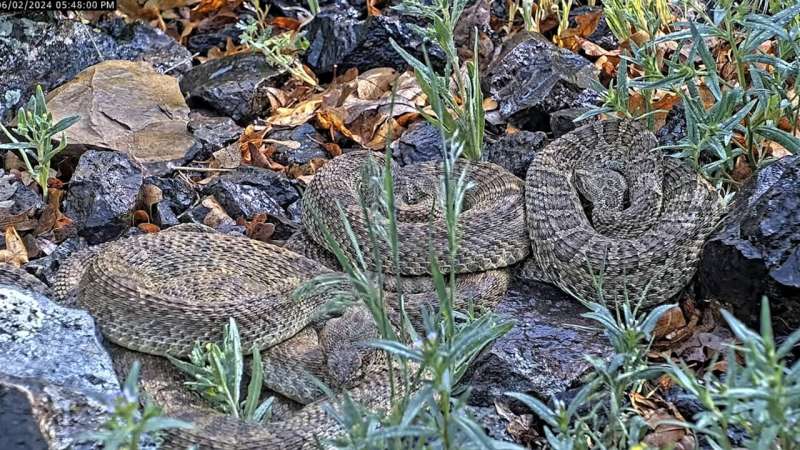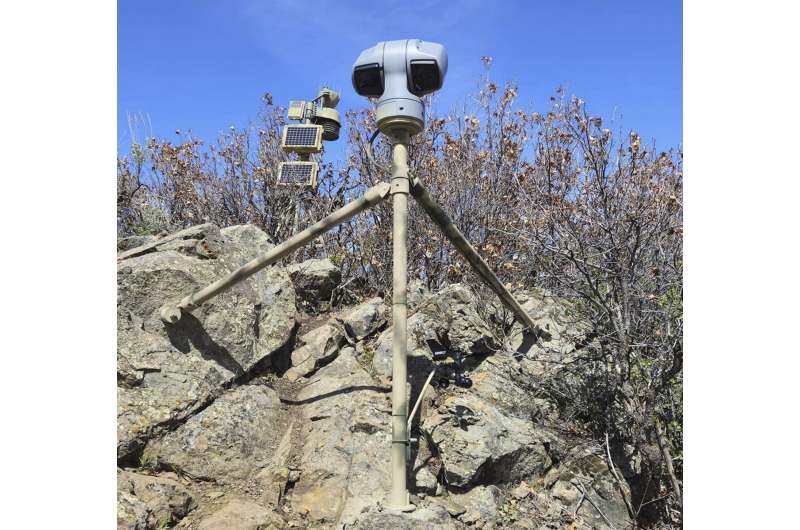This article has been reviewed according to Science X's editorial process and policies. Editors have highlighted the following attributes while ensuring the content's credibility:
fact-checked
reputable news agency
proofread
Webcam monitors hundreds of rattlesnakes at a Colorado 'mega den' for citizen science

They creep, slither and slide over and around each other by the dozen and now there's a webcam so that anybody can watch them online at any time, even at night.
A "mega den" with as many as 2,000 rattlesnakes isn't top binge-watching for many people. But it's a viewing bonanza for scientists and other snake enthusiasts whose observations are helping to broaden understanding of these unusual—and undeservedly maligned—reptiles.
The remote site on private land in northern Colorado is on a hillside full of rock crevices where the snakes can keep warm and hide from predators.
"This is a big, big den for rattlesnakes. This is one of the biggest ones we know of," Emily Taylor, a California Polytechnic State University biology professor leading the Project RattleCam research, said Tuesday.
The Cal Poly researchers set up the webcam in May, working off their knowledge from a previous webcam they set up at a rattlesnake den in California. The exact location in Colorado is kept secret to discourage snake lovers—or haters—from messing with the snakes, Taylor said.
The high-elevation Colorado rattlesnakes take refuge in the den for winter and emerge in the spring for a short season of activity compared to rattlesnakes in the Southwest. This time of year, only pregnant female snakes are at the den while males and not-pregnant females move into the lower country nearby.

In August, the babies will be born. They're called pups and, unlike nearly all other reptiles, they do not hatch from eggs but are born alive.
Also unlike other snakes, rattlesnake mothers care for their young, protecting them against predators and shielding them with their bodies. Sometimes rattlesnakes even care for the young of others.
"Rattlesnakes are actually really good mothers. People don't know that," Taylor said.
A webcam helps scientists observe snake behavior without interfering. Meanwhile, people watching online tip off scientists to events they miss, or clue them in with their own knowledge about the local environment.
"It truly is a group effort, a community science effort, that we couldn't do on our own as scientists," Taylor said.
Now and then, there's drama.
Red-tailed hawks circle above, awaiting a chance to swoop in for a meal. Once a magpie—a relative of crows with black, white and blue coloring and a long tail—caught a baby rattlesnake.

When it rains, the rattlesnakes coil up and catch water to drink from the cups formed by their bodies.
Taylor expects a surge in activity after the pups are born—then even more in September as snakes return from surrounding areas in preparation for winter.
Rattlesnakes get a bum rap as creepy and threatening. But the webcam shows they're social animals that don't go out of their way to be aggressive, Taylor pointed out.
"I try to speak up for the underdog and to show people that rattlesnakes have this other side that's really worthy of our admiration," said Taylor.
© 2024 The Associated Press. All rights reserved. This material may not be published, broadcast, rewritten or redistributed without permission.



















